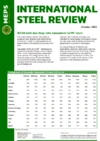US auto strikes hit steel coil price sentiment
The ongoing strikes at three of the largest car manufacturers in the United States are likely to exacerbate the current difficulties faced by domestic steel market participants.
Steel coil prices have been tumbling since April 2023, due to weakening demand and an increase in supply.
In an attempt to halt further erosion, domestic producers announced a list price increase, a few months ago. However, the measure failed to gain any market support.
The triggering of strikes, after Ford, General Motors and Stellantis failed to reach a pay agreement with the United Auto Workers (UAW) union earlier this month, will do little to improve the market situation.
Automotive has been one of the strongest performing steel-using industries in recent times.
US steel manufacturers – notably integrated mills – are hugely reliant on the strength of their auto order books to fill their production schedules. There are few other sectors that could fill this void.
The actions of the Federal Reserve to raise interest rates – in an effort to combat inflationary pressures – are weighing down heavily on market sentiment.
Demand for consumer goods remains low. New projects – especially private investments – are being delayed, due to the high cost of borrowing.
Consequently, US steel market participants are concerned about the impact of the automotive strikes. Much will depend on the length and severity of the union action.
A growing number of service centres believe that the market situation will get worse before it gets better. A price floor has yet to be created.
Nevertheless, a few causes for optimism exist.
Any potential loss in activity is likely to be slightly offset by planned maintenance, at both mills and carmakers, during the autumn. It is predicted that up to one million tonnes of steel production could be taken out, limiting the extent of further price decreases.
Imported volumes are unlikely to be a large consideration, in the Midwest region, during the winter months. The closure of the Great Lakes navigation is fast approaching.
Moreover, the Section 232 legislation will continue to deter the presence of low-cost alternatives from non-North American sources.
Despite the recent price slide, steel coil values in the United States remain among the highest in the world, particularly those for value-added products.
Consequently, the consensus view from MEPS’ research in September is that US prices have the potential to fall further, in the next few months.
Market participants report that November and December are traditionally challenging months, demand-wise. This is due to the holiday periods and the onset of winter.
Steel-related companies, particularly those linked to the automotive supply chains, are expected to keep their inventories to a minimum, given the current uncertainty.
Many US buyers initially predicted that steel coil prices would gradually decline for the rest of the year.
Any prolonged strike action, however, would lead to larger-than-expected price decreases if the overcapacity of steel production persists.
Conversely, resolution of the dispute between carmakers and the UAW may encourage mills to push for price increases.

Source:
International Steel Review
The MEPS International Steel Review is an essential monthly publication, offering professional analysis and insight into carbon steel prices around the world.
Go to productRequest a free publication





